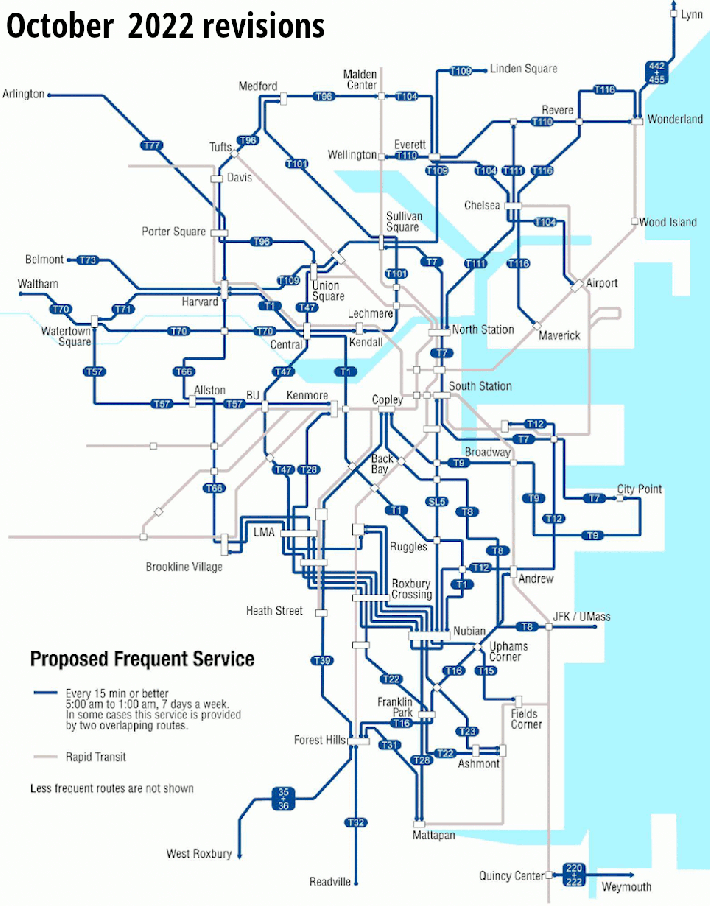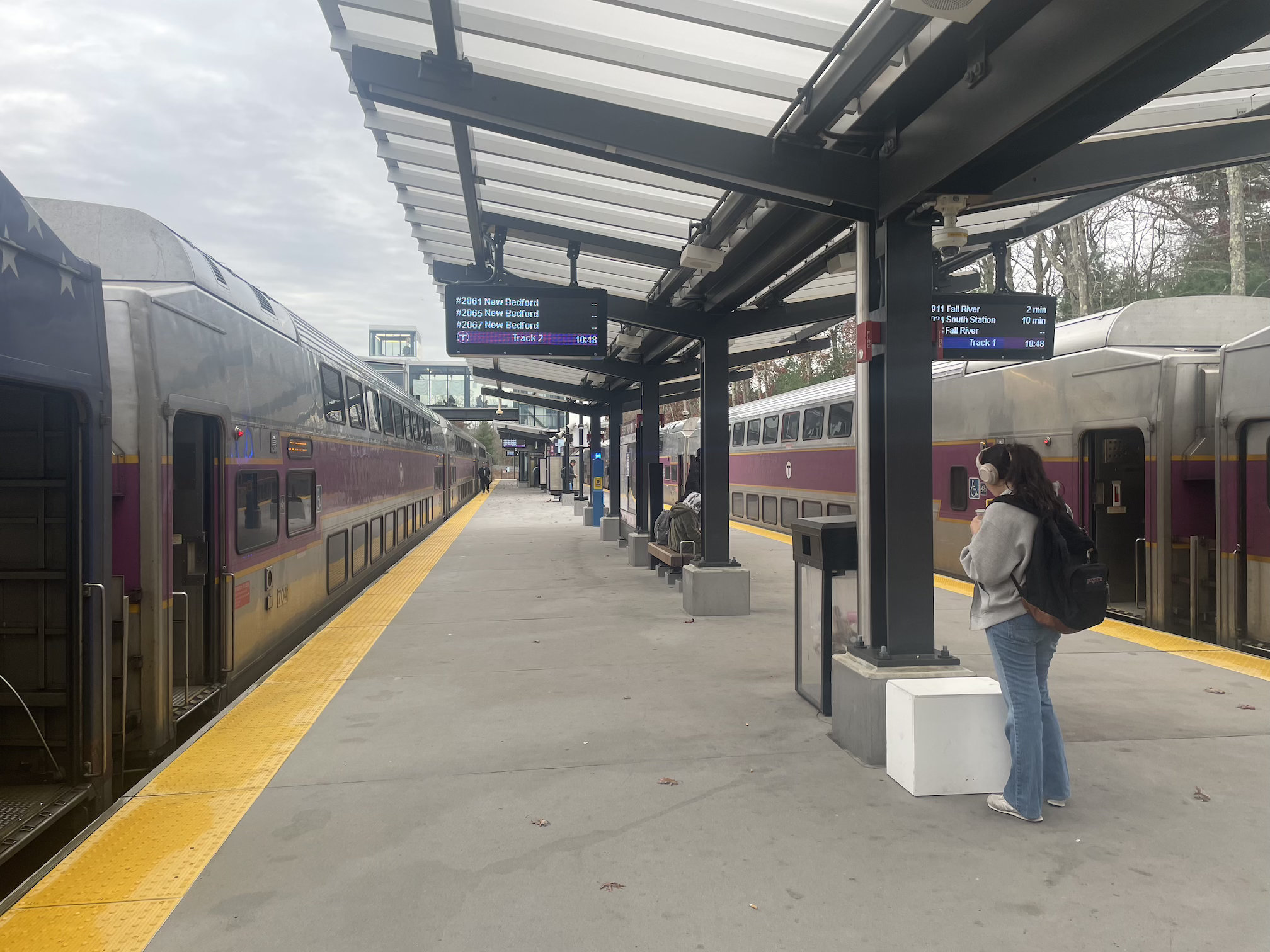The MBTA has released a revised proposal for a redesigned bus network map, based on thousands of comments it received from riders and municipal stakeholders this spring and summer.
The new map tweaks the draft network map that was released in May. The updates made changes to roughly two-thirds of the routes that were proposed earlier this year, but key elements – like the commitment to a 25 percent increase in overall bus service and a network of new "high-frequency" bus routes where buses would arrive every 15 minutes or better for 20 hours a day, 7 days a week – remain unchanged.
MBTA and MassDOT published their new proposal Wendesday morning on a new webpage and on an interactive map.
The revised proposal incorporates feedback from over 20,000 public comments the T received this spring and summer after it released a first draft of a new bus network.
Over half of those comments came from residents of just two relatively wealthy communities: Somerville and Cambridge.
But the T also made efforts to reach riders who have less time to participate in public hearings, by sending out representatives to solicit feedback at busy bus stops in communities like Chelsea. And in addition to all their outreach, they also conducted "inreach" to get feedback from some of the biggest experts on the current bus network: the T's own bus drivers.
Doug Johnson, a transportation planner at MassDOT, said that the feedback – and the changes that the T made in response to that feedback – generally fell into three themes.
Many commenters weighed in with concerns about losing access to specific bus routes, like the 55 in Fenway, and the 80, 87, and 88 routes in Somerville and Medford.
Other riders expressed concerns about route changes that would eliminate their one-seat rides to key destinations, like a senior housing complex or a grocery store.
“We keep joking that a lot of the changes we made were to improve access to Market Baskets because so many of our riders, especially seniors, are using buses to get to grocery stores,” said Johnson.
Other revisions were based on a desire from bus drivers and some municipal stakeholders to avoid unusually long routes, based on concerns that a delay on one part of a long route could create huge ripple effects on the rest of the route.
For instance, the May proposal called for the 39, which currently runs from Forest Hills to Back Bay along Centre Street and Huntington Avenue, to be re-routed through the Longwood Medical Area and extended all the way to Porter Square on the Somerville/Cambridge city line.
In the T's latest proposal, the 39 will stay where it is today, and a revised 47 bus route will provide frequent-service connection between Somerville and the Longwood area.

“We think reliability concerns can be addressed by things like bus lanes and transit signal priority, so that those buses aren’t getting bogged down in traffic congestion as much, but even if we get all the transit priority that we’re looking for in the network, with some routes, it can still be a lot to ask of an operator," explained Johnson.
In spite of the many changes made to specific bus routes, the overall shape of the new "frequent-service" bus route map – the backbone of the proposed new bus network – remains overwhelmingly similar to the map that was presented earlier this year. Multiple new frequent-service bus routes would connect historically under-invested neighborhoods like Roxbury, Chelsea, and Mattapan to fast-growing employment areas like the Longwood Medical Area.
María Belén Power, the Associate Executive Director of GreenRoots in Chelsea, praised the T for listening to riders and stakeholders and making constructive changes to their proposal based on the feedback they heard.
"I have to say, the MBTA gets a lot of heat from us in Chelsea, a lot of critique and critical feedback, and I just want to point out that the process in Chelsea – speaking from my community and our organization – it's been really responsive, and open, and communicative. The one big concern we had with a route, there was really good feedback and response," said Power during Wednesday's virtual meeting.
The MBTA board is expected to make a preliminary vote on the proposed new bus network at its November board meeting, then it could make a final vote to endorse the plan in December, after the T completes an equity analysis of the changes.
After that, the T would begin rolling out a few new bus routes each summer for 5 years, until the new bus network is fully implemented.
“Planning for the initial phase of implementation is underway right now," Johnson told StreetsblogMASS during a press briefing on Tuesday morning. "We would expect that first phase of service changes to happen next summer, but we haven't figured out exactly what the scale or scope of those changes would be yet.”
But for now, the T's ongoing bus driver shortage and aging bus garage facilities will likely prevent any major changes happening in 2023.
"In the early years of implementation, it is likely that we will focus on operator-neutral changes we can make, and really get the capital work (like new bus lanes, garages, and bus stops) underway," said Johnson.
The goal to increase overall bus service by 25 percent above pre-pandemic levels would require "an extra 440 additional drivers" plus dozens of other support positions, like bus mechanics and dispatchers, according to Melissa Dullea, the T's Senior Director of Service Planning.
That would be in addition to the 312 new bus operators the T needs to hire now to address its current shortage of bus drivers – a shortage that forced it to cut bus service this summer and last winter.
"All in all we’re looking at hiring something around 750-plus bus operators, which is closer to a 50 percent increase in the number of bus operators that we have today," said Dullea. "So it’s a really quite massive number."
Grecia White contributed reporting for this story.






